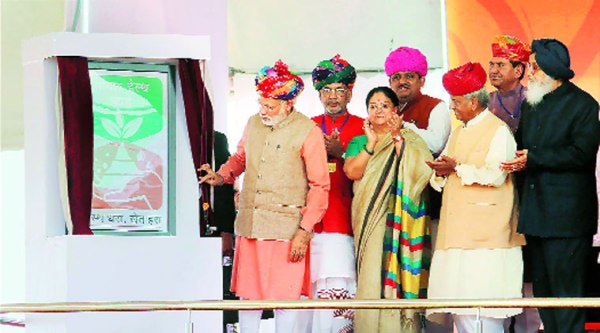On Thursday, Prime Minister Narendra Modi launched a nationwide ‘Soil Health Card’ scheme from Suratgarh in Rajasthan. Harish Damodaran explains what the scheme entails and its potential benefits for Indian agriculture

It aims to provide a soil health card to every farmer in India over the next three years. Taking the country’s total cultivable area of around 141 million hectares and an average holding of one hectare, it means distributing 141 million cards. The plan is to cover 30 million farmers in 2015 and 55 million each in the following two years.
Isn’t that too ambitious?
On the face of it, yes. Issuing the cards requires collecting soil samples from individual fields and testing these in laboratories. A soil testing laboratory can analyse 10,000-odd samples on an average annually. If one-third of 141 million fields are to be covered every year, we would need 4,700 laboratories, as against only about 1,250 —1,050 stationary and 200 mobile — today. How this capacity gap is going to be bridged isn’t clear. But given that the government wants soil testing to be done once in three years in every field, it opens up opportunities for the setting up of laboratories “by a new class of entrepreneurs even in small towns”, according to Modi.
Story continues below this ad
If I am a farmer, what will my soil health card show?
It will tell me the quality and fertility status of the soil in my field. Such an analysis is based on quantitative parameters, both physical and chemical. The former relate to soil depth, colour, texture, surface/subsurface hardness, compaction, etc. The chemical parameters include soil pH (to indicate acidity or alkalinity), electrical conductivity (a measure of salinity) and the levels of available nutrients: primary (nitrogen, phosphorous, potash), secondary (sulphur, calcium, magnesium) and micro (iron, zinc, copper, manganese, boron, molybdenum).
What use is such information to me as a farmer?
The quality and yields of the crops I grow are significantly influenced by the capacity of my soil to supply plant nutrients in the desired amounts to facilitate optimal growth. It is more than useful to know what is good or bad about my soil. If it is acidic, I need to apply lime, just as soil alkalinity and salinity can be substantially corrected through gypsum treatment and ensuring no water-logging.
Will this help reduce my fertiliser consumption?
Story continues below this ad
Fertiliser consumption depends not just on the available plant nutrients in my soil, but also what crops I am growing. Wheat or rice, for example, require more nitrogen, while phosphorous is the most important nutrient in pulses and potassium is indispensable for tomato, banana or pineapple.
Information on soil nutrient status is not meant to reduce fertiliser consumption as much as helping choose the right fertilisers in the right combination. Currently, I may be applying two bags of urea, which only contains 46 per cent nitrogen. If my field is deficient in sulphur, it might make sense to replace one bag of urea with ammonium sulphate that has 20.6 per cent nitrogen and also 24 per cent sulphur.
Over time, as soil testing becomes an established practice, the market could shift increasingly to customised fertilisers. Instead of selling plain urea or di-ammonium phosphate, companies may start offering the same fertilisers fortified with zinc or boron. Further, they could introduce customised products, tailored for particular crops in specific regions (say, potato in Farrukhabad or groundnut in Anantapur).
Why is the government pushing the soil health card scheme?
Story continues below this ad
The scheme is intended to promote balanced fertilisation, leading to improved soil health. But no less important a consideration is containing the mounting fertiliser subsidy bill, which, if fully provided for, comes to over Rs 100,000 crore annually. Two-thirds of this is on account of urea alone. If the scheme helps in weaning away farmers from overuse of urea, both they as well as the government stand to gain. Besides, it could make urea price decontrol politically more acceptable.
How much will soil testing cost?
Soil testing laboratories are now typically charging Rs 150 or so per sample for basic parameters: pH, electrical conductivity, and primary and secondary nutrient content. For micronutrients, the cost can be Rs 100 or more per parameters. This is because their testing requires use of costly reagents and equipment such as atomic absorption spectrophotometer (AAS).
An AAS costs anywhere between Rs 15 and Rs 25 lakh, while other equipment (pH and conductivity meters, shaking apparatus, electronic balance, drying oven, etc) come for another Rs 10 lakh. If one were to also add chemicals, glassware, standby generator and other materials, the capital cost for a testing laboratory may be upwards of Rs 75 lakh. All these costs — plus salaries to lab technicians and utility charges — have to be recouped from farmers or the government in case it chooses to subsidise soil testing.

 Prime Minister Narendra Modi with Rajasthan CM Vasundhara Raje at the launch of the scheme. (PTI)
Prime Minister Narendra Modi with Rajasthan CM Vasundhara Raje at the launch of the scheme. (PTI)





































